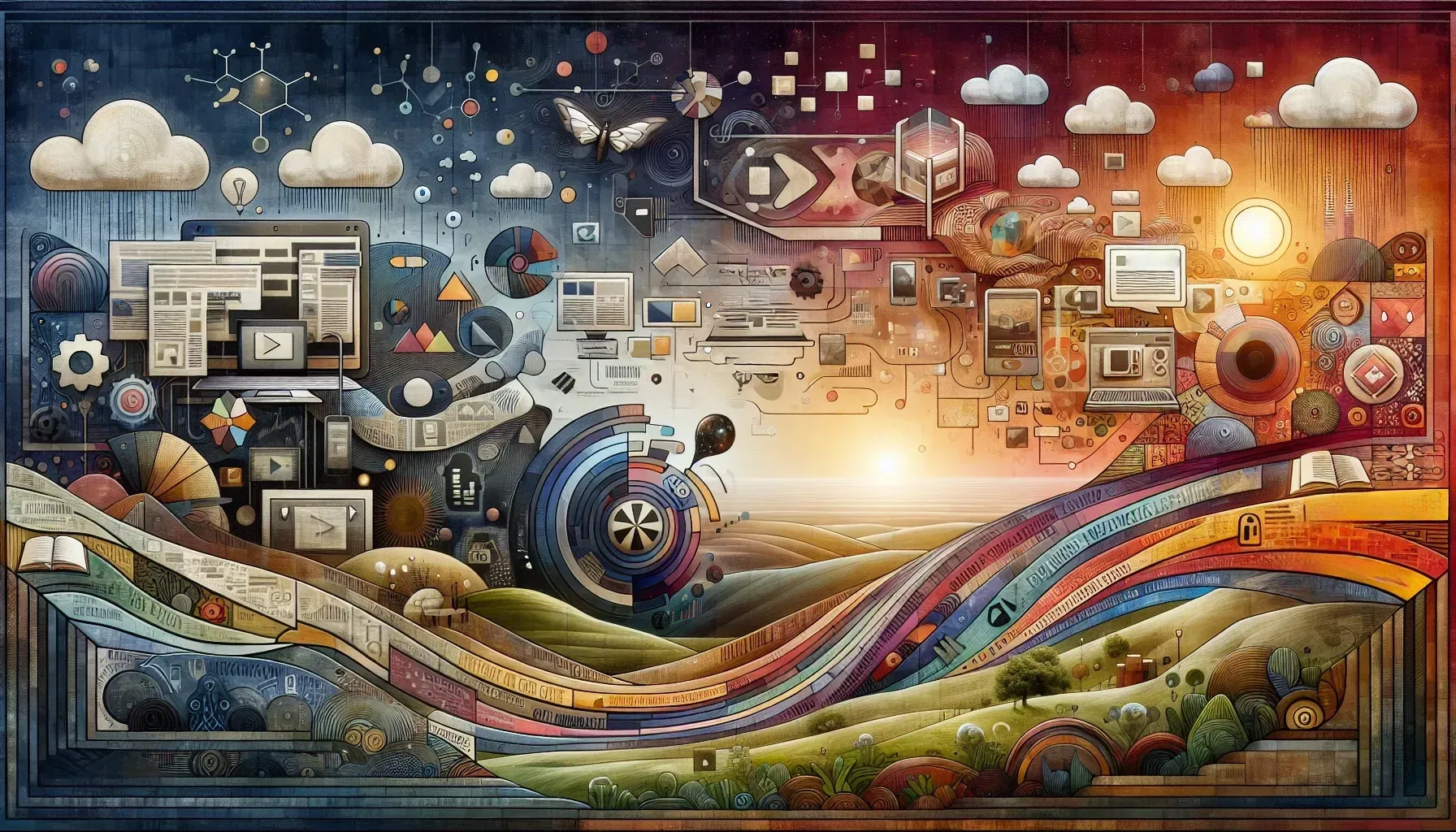The Genesis of Digital Storytelling: How Content Marketing Was Born

In the digital age, content marketing stands as a powerhouse, but its roots extend back centuries. Marketing has always been about telling stories that captivate audiences, and so, the concept of digital storytelling draws from a rich lineage of narrative marketing techniques.
Tracing the Origins of Digital Storytelling
The transition from traditional print marketing to digital narratives was not merely a shift in medium but also a profound evolution in communication strategies. Formerly, brands relied on static print ads, brochures, and billboards to convey their message. However, the digital revolution ushered in an era where marketers could engage audiences through dynamic content that resonated with their interests and needs.
As digital platforms expanded, the blogging boom emerged as a pivotal milestone in content marketing. Blogs provided an informal space for brands to humanize their voice, share authentic stories, and build deeper connections with their audience. They empowered businesses to position themselves as thought leaders while fostering engagement through informative and entertaining content.
Bloggers became influential figures, wielding the power to shape consumer perceptions and drive brand affinity. Businesses leveraging blogs were at the forefront of an emergent trend – the realization that compelling narratives could outperform traditional advertising in driving customer loyalty and engagement.
The Blogging Boom: A New Era in Content Marketing
ClicksBuzz Blog: The blogging boom redefined how businesses communicated with their audience, showcasing the potential power of relatable, narrative-driven content. This pivotal shift laid the groundwork for future content marketing strategies.
With the proliferation of social media and digital channels, marketers recognized the need to tap into emotional engagement. Content evolved beyond conveying information; it aimed to evoke emotions, foster empathy, and establish meaningful connections with consumers. Brands began integrating storytelling techniques that elicited joy, surprise, or curiosity to resonate with their audience on a deeper level.
Gone were the days of one-way advertising; brands now endeavored to weave narratives that sparked conversations and elicited user-generated content. This marked a paradigm shift wherein successful marketing no longer solely relied on promotional messages but nurtured authentic relationships with the audience.
Related Article: Visual Content Strategy: The Power of Infographics and Video Marketing in Digital Campaigns
Crafting Connection through Emotional Engagement
In the early 2000s, forward-thinking companies recognized the potential of blogs as integral components of their marketing mix. Brands leveraged blogs not only to disseminate information but also to establish their identity, values, and expertise within their domain.
The innovators behind these strategies understood that blogs served as conduits for story-driven marketing – an approach that transcended product-focused narratives and instead focused on creating an emotional resonance with consumers. This marked a pivotal transition away from overt sales pitches toward authentic brand storytelling.
ClicksBuzz Blog: The pioneering use of blogs by visionary brands encapsulates an important chapter in content marketing history. It demonstrates how effective narratives can forge enduring connections between brands and consumers.
Building Brands with Blogs: Innovators' Strategies
The emergence of interactive infographics revolutionized content consumption by visualizing data in engaging and easily digestible formats. These dynamic visuals helped break down complex information into compelling narratives, capturing attention and encouraging social sharing. By integrating data with storytelling elements, businesses could present statistics and trends in ways that resonated emotionally with their audience.
Interactive infographics not only made data more accessible but also exemplified how storytelling extended beyond textual content. It underscored the significance of visual narratives in creating impactful digital experiences amidst an increasingly visually-oriented online landscape.
ClicksBuzz Blog: The evolution of infographics serves as a testament to the power of visuals in conveying narratives. Understanding this evolution sets the stage for harnessing multimedia content for enhanced engagement.
Related Article: Interactive Content Marketing: Engaging Audiences with Quizzes, Polls, and Interactive Experiences
Interactive Infographics: Transforming Content Consumption
The advent of video marked a significant inflection point in content marketing. Video content offered a multisensory experience that captivated audiences in ways traditional text-based formats could not match. Not only did it facilitate effective storytelling, but it also enabled brands to showcase their products, personalities, and behind-the-scenes stories in compelling ways.
With the rise of platforms like YouTube and subsequent dominance of video on social media channels, brands found new avenues to communicate authentically, evoke emotions, and foster genuine connections with their audience through visual narratives.
The convergence of SEO and storytelling gave rise to a new paradigm where organic search visibility intertwined with narrative-driven content strategies. Marketers realized that compelling stories enriched with relevant keywords could not only captivate audiences but also enhance search engine rankings – thus propelling content into broader visibility across digital platforms.
The Rise of Video Content in Marketing
This fusion led to a shift from keyword stuffing to strategic integration where SEO seamlessly complemented storytelling prowess. Narrative-rich content optimized for search engines proved instrumental in drawing qualified traffic while elevating brand authority through valuable, informative storytelling.
The dawn of Web 2.0 brought forth a fundamental transformation – individuals morphing into active participants rather than passive consumers. User-generated content (UGC) emerged as a vibrant manifestation of this shift. Brands began harnessing UGC not only as testimonials but also as authentic narratives co-created with their community – fostering a sense of belonging while leveraging peer-to-peer influence.
UGC embodied diverse voices resonating with diverse audiences–enabling brands to curate authentic stories that reflected real experiences and engendered communal participation in brand narratives.
SEO and Storytelling: Merging Strategies for Success
ClicksBuzz Blog: Understanding UGC's role in digital storytelling unveils new prospects for harnessing user-driven narratives to fortify brand-consumer connections – an essential evolution steering contemporary content strategies.
As search algorithms grew more sophisticated, focusing on user intent transcended mere keyword optimization. Content strategists began delving into consumer psychology–seeking to understand and address user intent throughout each stage of the customer journey with narrative-driven experiences tailored to specific audience needs.
User-Generated Content: Empowering Community Voices
Brands recognized that aligning narrative-rich content along each touchpoint could guide consumers seamlessly through conversion funnels while fostering trust, credibility, and long-term relationships evolving practices emphasizing relevance over mere visibility for sustained impact across diverse digital channels.
ClicksBuzz Blog: Unveiling this transition from keywords to intent illuminates how tailored narratives aligning with user intent poise digital marketers for strategic resonance across multifaceted audience touchpoints.
In conclusion, understanding the genesis of digital storytelling illuminates its profound impact on contemporary content strategies. From print ads evolving into immersive multimedia experiences, tracing this trajectory unveils how captivating narratives continue to steer brand-consumer interactions – setting the stage for future innovations anchored in immersive storytelling dynamics.
Frequently Asked Questions
Digital storytelling is crucial in content marketing as it transforms traditional advertising into engaging narratives. It allows brands to connect emotionally with audiences, fostering loyalty and deeper relationships through relatable and authentic stories.
Blogs revolutionized content marketing by providing brands a platform to share authentic stories and humanize their voice. This shift enabled businesses to engage audiences more effectively, positioning themselves as thought leaders while fostering community interaction and brand affinity.
User-generated content (UGC) plays a vital role in digital storytelling by allowing consumers to co-create narratives with brands. This fosters a sense of community and belonging, enhancing authenticity and trust while enabling brands to reflect diverse voices and real experiences.
Check Out These Related Articles

Storytelling Across Channels: Crafting Multichannel Narratives for Consistent Engagement

The Art of Communicating Through Socials: Crafting Effective Content Strategies for Digital Marketing

Crafting Voices: How Emotional Intelligence Powers Today’s Digital Campaigns

